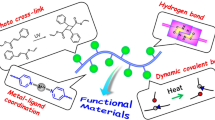Abstract
Advanced functional polymers represent the class of materials with unique properties and applications in a variety of fields. This book covers recent advances in the synthesis and applications of advanced functional polymers including smart polymers, shape memory polymers, self-healing polymers, biopolymers, etc. The book also highlights the applications of these functional polymers in advanced functional polymers in various fields including lamellar membranes, paints, coatings, composite implants, zero-G applications, etc. The characterisation and recycling techniques for these polymers and composites are also discussed in the book.
Access provided by Autonomous University of Puebla. Download chapter PDF
Similar content being viewed by others
Polymers-based materials are currently leading most of the current technological developments and these materials hold huge significance in many industries and applications. This book is targeted at advanced functional polymers, from synthesis to applications. The book has been split into ten different chapters covering the basic polymers to advanced application areas.
Chapter 2 covers the stereospecific polymerization techniques of different types of polymers, providing a brief overview related to the stereochemistry of polymers with mechanical, thermal, and electrical properties.
Chapter 3 is focused on Lamellar Membranes, providing a comprehensive review of two-dimensional (2D) nanomaterials that provide tremendous potential for separation applications. In lamellar membranes, mass transport occurs through the inherent interplanar spacing of the nanomaterials and the nanochannels generated during the fabrication of lamellar membranes. Various routes for preparing lamellar membranes including 2D nanosheet synthesis strategies, assembling techniques, mechanisms involved in transportation, and regulation of nanochannels are discussed in this chapter.
Polymeric paints and coatings are addressed in Chap. 4. Polymeric coatings are applied on surfaces of metal, wood, plastics, and other products to offer protection, decoration, and special functions. The key trends in polymeric coatings, modern synthesis technologies, and other approaches are discussed in this chapter.
Chapter 5 covers smart polymers and composites used for various applications like fuel cells, bio-medical applications, temperature & pH-responsive polymers, membranes, and nanocomposites. The increased popularity of smart polymers and composites is attributed in terms of environmental friendliness, stimuli-responsive, and energy efficiency as a fuel cell and smart filtration process as a membrane.
Chapter 6 describes the self-healing elastomers, their complex structures, and various healing strategies. Elastomers with good mechanical performance and healing efficiency typically do not exist, as a self-healing mechanism limits the mechanical properties. This chapter focuses on self-healing elastomers in which covalent bonds in combination with noncovalent interactions provide the best balance between repairability and mechanical performance.
Chapter 7 presents biodegradable plastics of synthetic origin including aliphatic polyesters, aromatic copolymers, vinyl polymers, and biodegradable polyurethanes. Biodegradation (both biotic and abiotic) in synthetic-origin biodegradable polymers has been discussed followed by the classification and degradation tendencies in synthetic-origin biodegradable plastics.
Chapter 8 focuses on bioinspired polymer composite implants. Flexible fiber-reinforced composite prostheses respond to biologically friendly healing (secondary healing) and promote callus generation and soft tissue maturation and can provide solutions to problems. The performance of these composites from the published work according to different materials is discussed.
Functional polymers and composites for zero-gravity applications are deliberated in Chap. 9, including environmental conditions in zero-gravity (zero-G), Various structures used, and the material requirements for these structures. The commonly used materials for zero-gravity including polymers for thermal blankets, adhesives, polymer aerogels, shape memory polymers, fiber-reinforced composite materials, fiber metal laminates, protective coatings against atomic oxygen exposure, and lunar dust adhesion, etc. have been detailed in this chapter.
Chapter 10 focuses on the modern characterization techniques for functional polymers. Some of the advanced characterizations techniques discussed include Dynamic Mechanical Analysis (DMA), Thermal Mechanical Analysis (TMA), Atomic Force Microscopy (AFM), 4-Probe technique, Inverse Gas Chromatography (IGC), and Gel Permeation Chromatography (GPC).
The last chapter of the book targets the polymer and composite recycling techniques. Primary, secondary, and tertiary recycling techniques for thermoplastics are discussed in this chapter. Thermal, mechanical, and chemical waste recycling techniques for thermosets and the inherent recyclability of thermoset polymers are focused on in this chapter. The potential applications of recycled thermoplastics and thermosets are also discussed.
Author information
Authors and Affiliations
Corresponding author
Editor information
Editors and Affiliations
Rights and permissions
Copyright information
© 2023 The Author(s), under exclusive license to Springer Nature Singapore Pte Ltd.
About this chapter
Cite this chapter
Shaker, K., Hafeez, A. (2023). Introduction to “Advanced Functional Polymers: Synthesis to Applications”. In: Shaker, K., Hafeez, A. (eds) Advanced Functional Polymers. Engineering Materials. Springer, Singapore. https://doi.org/10.1007/978-981-99-0787-8_1
Download citation
DOI: https://doi.org/10.1007/978-981-99-0787-8_1
Published:
Publisher Name: Springer, Singapore
Print ISBN: 978-981-99-0786-1
Online ISBN: 978-981-99-0787-8
eBook Packages: Chemistry and Materials ScienceChemistry and Material Science (R0)




